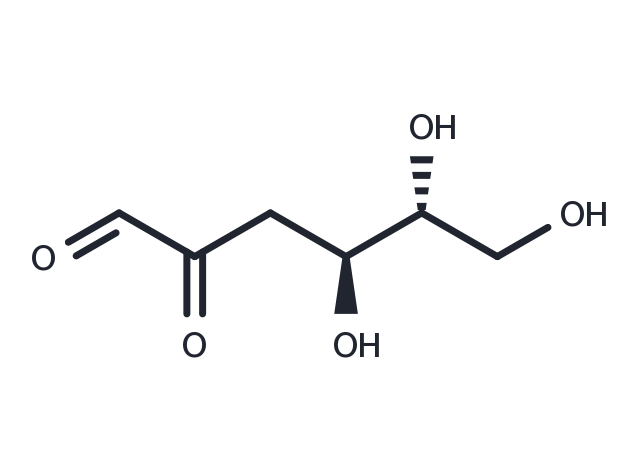store at low temperature
Powder: -20°C for 3 years | In solvent: -80°C for 1 year
3-Deoxyglucosone(3-Deoxy-D-glucosone) is synthesized by the intermediate pathway of the melad and polyol reactions.3-Deoxyglucosone reacts rapidly with protein amino groups to form advanced glycosylated end proteins (AGEs).3-Deoxyglucosone inactivates glutathione peroxidase and synergizes with low glucose to enhance GLP-1 secretion.3-Deoxyglucosone is used as a biomarker for diabetes mellitus.3-Deoxyglucosone has been shown to be an inhibitor of GLP-1 secretion in the presence of low glucose. 3-Deoxyglucosone inactivates glutathione oxidase, synergizes with low glucose to enhance GLP-1 secretion, and can be used as a biologic marker for diabetes.

| 説明 | 3-Deoxyglucosone(3-Deoxy-D-glucosone) is synthesized by the intermediate pathway of the melad and polyol reactions.3-Deoxyglucosone reacts rapidly with protein amino groups to form advanced glycosylated end proteins (AGEs).3-Deoxyglucosone inactivates glutathione peroxidase and synergizes with low glucose to enhance GLP-1 secretion.3-Deoxyglucosone is used as a biomarker for diabetes mellitus.3-Deoxyglucosone has been shown to be an inhibitor of GLP-1 secretion in the presence of low glucose. 3-Deoxyglucosone inactivates glutathione oxidase, synergizes with low glucose to enhance GLP-1 secretion, and can be used as a biologic marker for diabetes. |
| In vitro | 3-Deoxyglucosone (80 ng/ml-1000 ng/ml; 1 hour; STC-1 cells) induces a noteworthy 1.23-fold increase in GLP-1 secretion specifically in the 300 ng/ml and 1000 ng/ml 3DG-treated groups. However, at a lower concentration of 80 ng/ml, no discernible effects are observed. Notably, 3-Deoxyglucosone at 300 ng/ml significantly elevates intracellular Ca2+ levels, as determined by Fluo-3/AM (2.5 μM for 30 mins). In contrast, 3DG does not impact intracellular cAMP levels in a cAMP Elisa assay. Furthermore, at a concentration of 300 ng/ml, 3-Deoxyglucosone significantly enhances the protein expression levels of TAS1R2, TAS1R3, and TRPM5 under both glucose-free and high conditions.[1] |
| In vivo |
3-Deoxyglucosone (20 mg/kg; intragastric administration; single dose) induces a deterioration in glucose tolerance, as evidenced by an increased Area Under the Curve (AUC). Plasma glucagon levels do not show significant differences. The administration of 3-Deoxyglucosone leads to the development of impaired glucose regulation (IGR) accompanied by evident dysfunction of pancreatic islet cells in both Kunming mice and SD rats.[2] 3-deoxyglucosone (5-50 mg/kg; gastric gavage; once daily; 2 weeks; SD rats) exhibits significant increases in the upper small intestine (1.4-fold), lower small intestine (1.4-fold), ileum (1.4-fold), and colon (two-fold) compared to basal levels in their respective control groups. Additionally, there is a noteworthy decrease in the protein expressions of TAS1R2, TAS1R3, and TRPM5 observed in both the duodenum and colon.[3] |
| 別名 | 3-Deoxy-D-glucosone, 2-keto-3-Deoxyglucose |
| 分子量 | 162.14 |
| 分子式 | C6H10O5 |
| CAS No. | 4084-27-9 |
store at low temperature
Powder: -20°C for 3 years | In solvent: -80°C for 1 year
You can also refer to dose conversion for different animals. 詳細
bottom
Please see Inhibitor Handling Instructions for more frequently ask questions. Topics include: how to prepare stock solutions, how to store products, and cautions on cell-based assays & animal experiments, etc.
3-Deoxyglucosone 4084-27-9 GPCR/G Protein oxidation-reduction GPX Glucagon Receptor 3-Deoxy-D-glucosone 2-keto-3-Deoxyglucose Inhibitor inhibitor inhibit
